RUSTING and OXIDATION
Anatomy of a fire
Combustion is the self-sustaining process of rapid oxidation of a fuel being reduced by an oxidizing agent along with the evolution of heat and light. Fires are defined by their physical characteristics. They may vary from very slow oxidation, as in rusting, to very fast oxidation, such as detonations and explosions.
Nuclear Heat Energy
Nuclear Fission and Fusion – The heat generated by either the splitting or combining of atoms.
http://www.lbfdtraining.com/RTM/Chapter3%20Fundamentals/Fire%20Behavior%20&%20Chemistry.html
Oxidation–reduction reaction
Also called redox reaction any chemical reaction in which the oxidation number of a participating chemical species changes. The term covers a large and diverse body of processes. Many oxidation–reduction reactions are as common and familiar as fire, the rusting and dissolution of metals, the browning of fruit, and respiration and photosynthesis—basic life functions.
http://www.britannica.com/eb/article-9110112/oxidation-reduction-reaction
Chemical vs nuclear burning
Question – How does the sun keep burning when there is no
oxygen? My student asked me this. I talked with him about nuclear
reactions. He looked up fire in the World Book. He found that fire
needs oxygen, fuel and heat. Can you explain this? Thank you. –Rise
P., teacher, Bloomington, IN
Answer – The definition that you were looking at is, narrowly, chemical burning in air. Fire, more formally, is the phenomenon of atomic (molecular)
recombination that is manifest by a new product and electromagnetic
radiation. Chemical combustion just rearranges the atoms from parent
material(s) to product material(s). The radiation given off is often light
or infra-red (heat). Note that this does not require oxygen. Oxidation
reactions are remarkably common, but by no means the only way to do this.
In nuclear burning, the atoms themselves are combined to create new and
different atoms. Nuclear burning does not require oxygen. The main
nuclear burning that is happening on the sun is a hydrogen-hydrogen
process, forming helium. There are other processes, too, but this is the
main one.
http://www.newton.dep.anl.gov/askasci/gen01/gen01159.htm
11 Steps to Survival
Know the Effects of Nuclear Explosions
A nuclear explosion releases vast amounts of energy in three forms:
- Light and heat
- Blast
- Radiation
The amount of energy released depends upon the size and design of the weapon. A wide range of weapons and delivery systems are available to an aggressor and we have no way of knowing what size of explosions might take place in Canada. For illustration purposes, we describe in this pamphlet the effects of a 5-megaton H-bomb equal to the explosive force of five million tons of TNT. Such a bomb could substantially damage the largest city.
The effects depend upon whether the weapon is exploded high in the air, or on, or near the ground. An air burst usually produces more fire and blast-damage than a ground burst which results in a big crater and more radioactive fallout. The effects described below are approximate for a 5-megaton explosion and can only be approximate since effects depend upon a number of conditions such as weather, terrain, etc.

Air burst

Ground burst
Light and Heat
A blaze of light brighter than the sun is produced by a nuclear explosion. It lasts for about 15 seconds. Temporary blindness and eye injury can result from the glare if eyes are not shielded. The heat rays from the explosion travel at the speed of light or about 186,000 miles per second. It can start fires up to 20 miles away. Many fires are caused when the heat pulse comes through a window to set fire to curtains, paper, clothing and furniture. The heat flash also can set fire to the outside of wooden buildings.
The following are some examples of the predictable effects on unprotected skin of the heat flash of a 5-megaton weapon exploded on a clear day:
- Skin is badly burned up to 15 miles from the explosion
- Skin is blistered up to 18 miles from the explosion
- Sunburn types of burns up to 23 miles from the explosion
Nuclear explosions in the air rather than on the ground are more likely to produce a greater number of serious burns through the heat flash. Clothing will give some protection. A shield between you and the light will give protection against burns from the heat flash.

Effects on Buildings
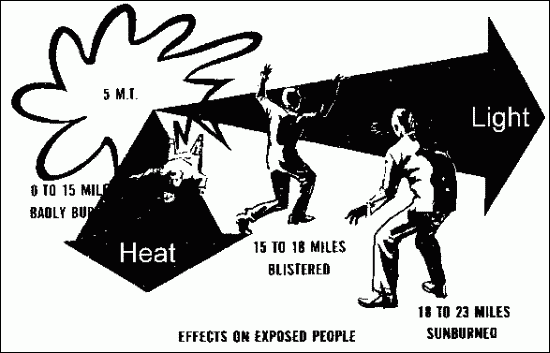
Effects on Exposed People
Blast
The blast wave travels more slowly than the heat flash. Several seconds may pass after you have seen the light or felt the heat before the blast wave reaches you, depending on the distance you are from the explosion. It is like the time between seeing the flash of lightning and hearing the sound of thunder. For example, at ten miles from the centre of an explosion, it would take about 35 seconds for the blast wave to reach you. If caught in the open during a nuclear explosion, this time can be used to find some protection from the blast wave.
You might be injured by being thrown about by the blast; therefore, keep low. The greatest danger is from flying glass, bricks and other debris. The blast from a 5-megaton explosion could injure people as far away as 15 miles.
Blast
The kinds of damage that the blast can do to buildings are:
- Complete destruction of all buildings three miles from the centre of the explosion.
- Damage beyond repair to buildings three to five miles distant. They would have to be torn down.
- Major repairs required to buildings five to 10 miles distant before they could be occupied.
- Light to moderate damage to buildings 10 to 15 miles distant. They could be occupied during repairs.
A 20-megaton bomb increases the approximate ranges of damage described above to five, eight, sixteen and twenty-four miles.
These are approximate distances as the strength of buildings is not uniform. For example, reinforced concrete buildings are more blast resistant than wood frame structures. In some areas four miles away from the explosion, concrete buildings might be repairable, while wood frame buildings would be completely destroyed. Windows, of course, are very vulnerable and are apt to be blown in as far away as 25 miles from the explosion.
Radiation
A nuclear explosion causes both immediate radiation and residual radiation. Immediate radiation is given off at the time of the explosion.
It is dangerous only within two or three miles. If you were near the explosion without adequate protection and managed to survive the effects of blast and fire, you could still be seriously affected by immediate radiation.
Residual radiation is given off by the radioactive particles left as “fallout” after the explosion. The danger from fallout would be so great and widespread that it is discussed separately, in >Step 2.
Protection against Heat, Blast and Immediate Radiation
The illustrations below show some of the most probable situations in which you might find yourself at the time of a nuclear attack, and what you should do:
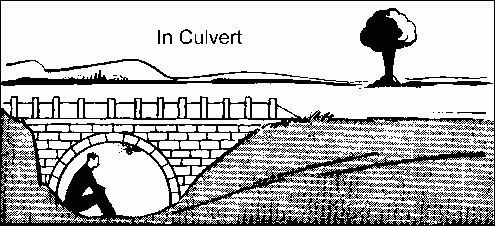
Protection against Heat, Blast and Immediate Radiation
Step 2: Know the Facts About Radioactive Fallout
If a nuclear weapon is exploded on, or near, the ground, danger from radioactive fallout is greatest. The force of the explosion may make a crater up to a mile wide and to a depth of one hundred feet. Millions of tons of pulverized earth, stones, buildings and other materials are drawn up into the fireball and become radioactive. Some of the heavier particles spill out around the point of explosion. The rest are sucked up into the mushroom cloud.
This radioactive material is then carried by winds until it settles to earth. This is called “Fallout”. Under some circumstances you may see the fallout; under others you may not.
The radioactivity it gives off cannot be seen. You can’t feel it. You can’t smell it.
But fallout doesn’t come out of the sky like a gas and seep into everything. It can best be described as a fine to coarse sand carried by the winds. Because the wind direction varies at different heights above the ground, it is not possible to judge from the ground where the fallout will settle. It can settle in irregular patterns hundreds of miles from the explosion.
The fallout from a 5-megaton explosion could affect seriously an area of 7,000 square miles. If nothing were done to gain protection during the period of high radioactivity, there would be a grave danger to life in that area.
Because fallout is carried so far and covers such a large area, it could be the greatest danger to the largest number of Canadians in a nuclear war. If Canada was not hit by nuclear bombs, those exploding in the United States close to our border could result in serious fallout in many parts of Canada.
There are four things which determine the amount of radiation reaching your body from fallout:
- The time that has passed since the explosion.
- The length of time you are exposed to fallout.
- The distance you are from the fallout.
- The shielding between you and the fallout.
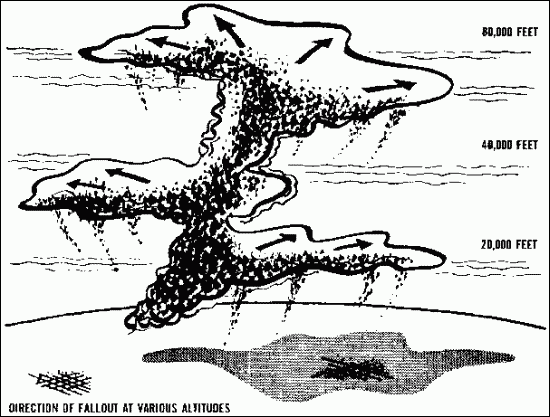
Direction of Fallout at Various Altitudes
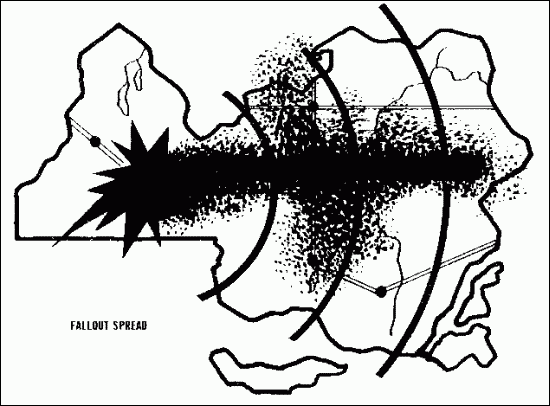
Fallout Spread
Time
The radioactivity in fallout weakens rapidly in the first hours after an explosion. This weakening is called “decay”. After seven hours, fallout has lost about 90% of the strength it had one hour after the explosion. After two days it has lost 99%; in two weeks 99.9% of its strength is gone. Nevertheless, if the radiation at the beginning were high enough, the remaining 0.1% could be dangerous.
Radiation must be measured by special instruments handled by people trained to use them. But, if you stay in a shelter during the first days following an explosion, you escape the strongest radiation. You should stay in the shelter until radiation has been measured and you have been told aver the radio that it is safe to come out.

Radiation Decay Time
Distance
The strength of radiation reaching your body is reduced the farther you are from the fallout. Here are some illustrations of the safest place to be when you are in various kinds of buildings.
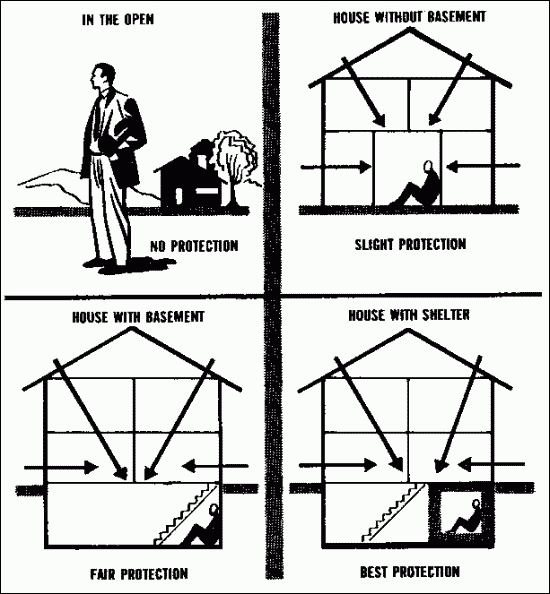
Distance Shielding
The most effective protection is to place some heavy material between yourself and the fallout. The heavier the material the better the protection. Many common materials give excellent protection. The materials and design of the fallout shelter recommended in Blueprint for Survival No. 1 will stop penetration of 99% of outside radiation.
These thicknesses of material will stop 99% of radiation:
- 16 inches of solid brick
- 16 inches of hollow concrete blocks filled with mortar or sand
- 2 feet of packed earth Ä 3 feet if loose
- 5 inches of steel
- 3 inches of lead
- 3 feet of water
A fallout shelter is the best way to protect your family and yourself against radiation because:
- It keeps the radiation at a distance.
- It shields you from radiation.
- The time spent there is the period when radiation is most intense.
By providing your family and yourself with a fallout shelter, you are unlikely to suffer serious effects from radioactive fallout.

Shielding
http://autonopedia.org/survival/Eleven_Steps_To_Nuclear_Survival.html
NUCLEAR STRIKE MATERIAL FROM MUSHROOM CLOUD
Mach stem video
VIDEO: MACHSTEM Dailymotion | AtomicArchive
If the explosion occurs above the ground, when the expanding blast wave strikes the surface of the earth, it is reflected off the ground to form a second shock wave. This reflected blast wave can merge with the incident shock wave. This merging phenomenon is called the “Mach effect”. The overpressure at the front of the Mach wave is generally about twice as great as that at the direct blast wave front. This footage is from a conventional explosion.
Ground Zero
Video of Hiroshima
VIDEO: Hiroshima Dailymotion | AtomicArchive
Video of damage at Hiroshima
VIDEO: Hiroshima Damage Dailymotion | AtomicArchive
VAPORIZATION
FROM: America’s Reaction to the Atomic Bomb
Hiroshima
“Any object within a two kilometer distance from the hypocenter [at Hiroshima] suffered significant burn damage, and those located near the hypocenter were instantaneously vaporized. The Shima hospital, the hypocenter of the atomic bomb was vaporized, along with all her patients.”
http://users.dickinson.edu/~history/product/steele/seniorthesis.htm
Nagasaki
Yukiharu did not realize at first that a bomb had exploded. He thought there had been an electrical accident at the plant building he was working in. Then it suddenly became dark and “I heard a huge explosion. The roof of the building had collapsed, and we were under the broken roof. I felt a pain in my head. I managed to escape from the building. I did not know what was happening to us, because we had not experienced any serious bombing [..] I was not badly hurt [..] A piece of broken glass was sticking into my head.”
http://users.dickinson.edu/~history/product/steele/seniorthesis.htm
Patricia Ondrovic Interview – Motorola Radio Troubles and Cellphone Problems
Killtown: After you witnessed the explosions in the lobby of the WTC 6, you started running in which direction and then what happened?
Patricia Ondrovic: I kept running west on Vesey. I got hit with the cloud shortly after being turned away from 6 WTC. I was probably at the corner of Vesey/West Street at that point running. I ran towards the West Side Highway — there is a park area there. I remember running across grass and there was now lots of gray and black smoke. I was just trying to get to the water because nothing was exploding, or on fire from what I could see. There were lots and lots of people also running that way at this point.
Killtown: When were you able to escape the dust cloud and what happened after that?
Patricia Ondrovic: I was now at the water’s edge. There were no boats I could see, so I started to run north along the side of the West Side Highway. I was about 9 or 10 blocks north of Vesey on the West Side Highway. I found the first FDNY EMS vehicle and knew the crew as they were also from my station. I remember not being able to breathe so well — felt like someone was standing on my chest. When I looked back, I could see people coming out of the black cloud and continuing to run and walk north on the West Side Highway as well.
Killtown: Did you notice any firefighters or other rescuers having technical problems with their Motorola radios or any other equipment?
Patricia Ondrovic: Oh yeah, at one point there was a loud “buzzing” sound and none of the EMS radios worked for maybe 30 seconds? We all used Motorola radios and I believe our repeaters were on top of the towers, so when the tower came down our radios failed. I tried to use my cellphone, but that too did not work.
Killtown: Do you know if anybody’s cellphone worked and were able to get through to anybody?
Patricia Ondrovic: A few of my co workers had Nextel phones. Theirs worked, but they couldn’t talk to anyone who didn’t have a Nextel because all the other services were out at the time.
http://killtown.blogspot.com/2006/02/911-rescuer-saw-explosions-inside-wtc.html
ROAR
Roar heard in Hiroshima and Nagasaki explosions
People farther from the point of detonation experienced first the flash and heat, followed seconds later by a deafening boom and the blast wave. http://www.mbe.doe.gov/me70/manhattan/hiroshima.htm
As the streetcar arrived in Hatchobori, Yohko continued to watch the pedestrians hurry along on their way to work. The next moment, “I was blinded for a moment by a piercing flash of bright light, and the air filled with yellow smoke like poison gas. Momentarily, it got so dark I couldn’t see anything. There was a loud, dull, thunderous noise.” [Hiroshima] http://users.dickinson.edu/~history/product/steele/seniorthesis.htm
Yukiharu did not realize at first that a bomb had exploded. He thought there had been an electrical accident at the plant building he was working in. Then it suddenly became dark and “I heard a huge explosion. The roof of the building had collapsed, and we were under the broken roof.” [Hiroshima] http://users.dickinson.edu/~history/product/steele/seniorthesis.htm
After finishing his shift at the factory, Akio Sakita returned home and went to his backyard to do the washing. He heard the drone of airplanes above, but since the air raid alarm had been called off, he assumed that the planes he saw were Japanese planes out on surveillance runs. At that moment, he heard a loud roar in the sky, and as he looked up, “wondering if it had in fact been the enemy, a blinding flash of light filled the sky and my body was showered in a wave of intense heat.” [Hiroshima] http://users.dickinson.edu/~history/product/steele/seniorthesis.htm
Trinity Test – Roar of explosion
At 05:29:45 local time (Mountain War Time), (11:29:45 GMT) the device exploded with an energy equivalent to around 20 kilotons of TNT (87.5 TJ). It left a crater of radioactive glass in the desert 10 feet (3 meters) deep and 1,100 ft (330 meters) wide. At the time of detonation, the surrounding mountains were illuminated brighter than daytime for one to two seconds, and the heat was reported as being as hot as an oven at the base camp. The observed colors of the illumination ranged from purple to green and eventually to white. The roar of the shock wave took 40 seconds to reach the observers.[4] The shock wave was felt over 100 miles (160 km) away, and the mushroom cloud reached 7.5 miles (12 km) in height. [..] http://en.wikipedia.org/wiki/Trinity_test
Audio and video of roar from 9/11 Eyewitness video seismic
VIDEO: Rick Siegel 9-11 Eyewitness-Booming sounds Dailymotion
VIDEO: Sound analysis shows explosives Dailymotion
Interview with Patricia Ondrovic
Killtown: What did you do when the South Tower started coming down?
Patricia Ondrovic: I didn’t know what was happening, but there was a loud “roar” — lots of crashing sounds. I was attempting to put my stretcher back into the vehicle. The ground was shaking and I saw a sea of people, mostly the various agencies on scene, Fire, Police, EMS, all running towards me. I had no idea what they were running from, but I decided I’d be ahead of them and just started running west towards the river. As I was running, parked cars were blowing up and some were on fire, the street was cracking a bit as well. Very shortly after I started running, everything became one big black cloud. I was near the West Side Highway and I couldn’t see around me anymore.
http://killtown.blogspot.com/2006/02/911-rescuer-saw-explosions-inside-wtc.html
Ondrovic Interiew – Buildings WTC 5 and 6 blowing up at the same time as WTC 2 (South Tower)
Killtown: Can you describe more about how the building blew up on you? Did you feel the shock wave from the explosion and/or debris falling down near you?
Patricia Ondrovic: Well, one second I was trying to put my stretcher into the ambulance, the next thing I know I am thrown to the ground as the ground was shaking. Debris was flying at me from where the building I was parked in front of. There was a continual loud rumbling, there was just debris flying from every direction and then everything being covered in the black and gray smoke.
Killtown: Let’s recap real quickly; your ambulance was parked backed up against the WTC 6, near the 6’s corner by the alleyway between the WTC 5 and 6 …
http://killtown.blogspot.com/2006/02/911-rescuer-saw-explosions-inside-wtc.html
Strange flash and fireball
In the official report on the test, General Farrell wrote, “The lighting effects beggared description. The whole country was lighted by a searing light with the intensity many times that of the midday sun. It was golden, purple, violet, gray, and blue. It lighted every peak, crevasse and ridge of the nearby mountain range with a clarity and beauty that cannot be described but must be seen to be imagined.”
News reports quoted a forest ranger 150 miles (240 km) west of the site as saying he saw “a flash of fire followed by an explosion and black smoke.” A New Mexican 150 miles (240 km) north said, “The explosion lighted up the sky like the sun.” Other reports remarked that windows were rattled and the sound of the explosion could be heard up to 200 miles (320 km) away.
http://en.wikipedia.org/wiki/Trinity_test
“A huge fireball formed in the sky. Directly beneath it is Matsuyama township. Together with the flash came the heat rays and blast, which instantly destroyed everything on earth.” [Nagasaki]
http://www.gensuikin.org/english/photo.html
Roar, rumbling and fireball
WRH – Comment
When the rescue team reached an area directly in front of Tower Two, Antonio said he’d take over the equipment cart Will had pushed from Building 5. [..] The team moved ahead. [..] Suddenly the hallway began to shudder as a terrible deafening roar swept over them. That’s when Will saw the giant fireball explode in the street. [bowhunter.com]
http://www.bowhunter.com/feature_articles/BN_FromTheRubble/
Video: Carol Marin saw and heard a fireball and roar
Carol Marin: “All of a sudden I heard a roar and I saw one of the towers blow … I saw from street level as though it exploded up, a giant rolling ball of flame …”
VIDEO: 911.wtc.carol.marin Dailymotion
Same reporter: “I hear simultaneously this roar and see what appears to be a gigantic fireball rising up at ground level . . . I remember seeing this giant ball of fire come out of the earth as I heard this roar” Running Toward Danger: Stories Behind the Breaking News of 9/11 – P 239 | Amazon
Glass, rumbling, wind
VIDEO: 911.WTC.glass.blew.out Dailymotion
“I was standing next to 1 World Trade Center and then all of a sudden I heard rumbling and we all started running away from it. The glass like blew out and threw me onto the sidewalk … and I couldn’t see for like twenty seconds …” http://whatreallyhappened.com/WRHARTICLES/thermite.php
Timothy Julian — Firefighter (F.D.N.Y.) [Ladder 118]
“You know, and I just heard like an explosion and then cracking type of noise, and then it sounded like a freight train, rumbling and picking up speed, and I remember I looked up, and I saw it coming down.
I made it right to the corner, and there’s a column right there, and I was with my guys. We all made it to like the column, and I remember it was plate glass behind me, and I’m thinking I’m going to get hit by this glass and like a porcupine. I’m going to get it, you know, but nonetheless, it rumbled.
It was the loudest rumbling I ever heard. The ground shook, and I got thrown down, and I remember it just got black, and I got knocked down. I remember geing buried.” Interview, 12/26/01, New York Times
Oral histories of rumbling and roar and ground shaking
Brian Becker — Lieutenant (F.D.N.Y.) [Engine 28]
“We felt — our whole building that we were in, when World Trade Center 2 collapsed, that was the first one to collapse. We were in World Trade Center 1. It was a tremendous explosion and tremendous shaking of our building. We thought it was our building maybe collapsed, there was a collapse above us occurring. It was tremendous shaking and like everybody dove into this stairwell and waited for, I guess, 20, 30 seconds until it settled, and that was our experience of the other building collapsing.” Interview, 10/09/01, New York Times
Michael Beehler — Firefighter (F.D.N.Y.) [Ladder 110]
“I was by I guess the outer part of the building and I just remember feeling the building starting to shake and this tremendous tremendous like roar and I just — I kind of didn’t even notice it, but like out of the corner of my eye, I saw out of the building, I saw a shadow coming down. At that point I thought it was the upper part of the north tower that had just basically like toppled over, fell off. I didn’t actually see the building part go by me, because I think I was on the opposite side. But I just remember feeling this tremendous tremendous shake and hearing this, like, noise. Again I can’t describe. What I did was I ended up running out.” Interview, 12/17/01, New York Times
Jody Bell — E.M.T. (E.M.S.)
“I lost track of time. You start to hear this rumble. You hear this rumble. Everything is shaking. Now I’m like, what the hell could that be. I’m thinking we’re going to get bombed. This is an air raid. You hear this thunder, this rumbling. Then you see the building start to come down. Everybody’s like, “Run for your lives! The building is coming down!” At that moment when that building was coming down, I was strapping a patient onto a stair chair.” Interview, 12/15/01, New York Times
David Blacksberg — E.M.T. (E.M.S.)
“I lost track of time of when the second building was coming down. It sounded like one big rumble, and then it just sounded like it just continued, and I was — I wasn’t really paying attention. I was looking at the sound.” Interview, 11/23/01, New York Times
Nicholas Borrillo — Firefighter (F.D.N.Y.) on 23rd floor of North Tower
“Then we heard a rumble. We heard it and we felt the whole building shake. It was like being on a train, being in an earthquake. A train is more like it, because with the train you hear the rumbling, and it kind of like moved you around in the hall. Then it just stopped after eight or ten seconds, about the time it took for the building to come down.” Interview, 01/09/02, New York Times
Peter Cachia — (E.M.S.) [Battalion 4]
“I was like a little too close to the tower when it started coming down, because when I started running, I knew I was too close and I really didn’t think I was going to get out of there. So about halfway up Liberty Street I saw a truck, I guess an SUV. It wasn’t a police or a fire vehicle. It was just a car that was parked there. I went under the truck while the tower came down and the ground was shaking and the truck was shaking and I thought that was it for me. I thought I was done. I stayed under there until I guess everything was over.” Interview, 10/15/01, New York Times
Paul Curran — Fire Patrolman (F.D.N.Y.) North Tower:
I went back and stood right in front of Eight World Trade Center right by the Customs House, and the North Tower was set right next to it. Not that much time went by, and all of a sudden the ground just started shaking [..]. It felt like a train was running under my feet. The next thing we know, we look up and the tower is collapsing. Interview, 12/18/01, New York Times
Timothy Julian — Firefighter (F.D.N.Y.) [Ladder 118]
“You know, and I just heard like an explosion and then cracking type of noise, and then it sounded like a freight train, rumbling and picking up speed, and I remember I looked up, and I saw it coming down.
I made it right to the corner, and there’s a column right there, and I was with my guys. We all made it to like the column, and I remember it was plate glass behind me, and I’m thinking I’m going to get hit by this glass and like a porcupine. I’m going to get it, you know, but nonetheless, it rumbled.
It was the loudest rumbling I ever heard. The ground shook, and I got thrown down, and I remember it just got black, and I got knocked down. I remember geing buried.” Interview, 12/26/01, New York Times
Comment about above account: He experienced overpressure of at least 5 psi to be knocked down.
Bradley Mann — Lieutenant (E.M.S.)
“Shortly before the first tower came down, I remember feeling the ground shaking. I heard a terrible noise, and then debris just started flying everywhere. People started running.” Interview, 11/07/01, New York Times
COMMENT: High-velocity winds causing debris to fly.
Keith Murphy — (F.D.N.Y.) [Engine 47]
“At the time, I would have said they sounded like bombs, but it was boom boom boom and then the lights all go out. I hear someone say oh, s___, that was just for the lights out. I would say about 3, 4 seconds, all of a sudden this tremendous roar. It sounded like being in a tunnel with the train coming at you. It sounded like nothing I had ever heard in my life, but it didn’t sound good. All of a sudden I could feel the floor started to shake and sway. We were being thrown like literally off our feet, side to side, getting banged around and then a tremendous wind starting to happen. It probably lasted maybe 15 seconds, 10 to 15 seconds. It seemed like a hurricane force wind. It would blow you off your feet and smoke and debris and more things started falling.” Interview, 12/05/01, New York Times
http://911research.wtc7.net/wtc/evidence/oralhistories/shaking.html
Loud boom of bomb going off in this video
VIDEO: FIremen hear bombing Dailymotion
Ground Zero



http://webfairy.org/missilegate/rfz/swaz/images/r-reich.of.the.black.sun_15.jpg URL: http://webfairy.org/missilegate/rfz/swaz/chapter5.htm Caption: In 1943 the Supreme Command of the Luftwaffe (Oberkommando der Luftwaffe) conducted a highly unusual study. The study consisted of a map, a map of lower Manhattan Island. On the map are concentric circles detailing the blast and heat damage- radii of an atomic bomb detonation over New York City. But the most unusual aspect of this “study” is that it shows the detonation of an atom bomb in the 15-17 kiloton range, approximately the same yield as the Little Boy uranium bomb dropped on Hiroshima, an odd “coincidence” in the series of “odd coincidences” we have- already encountered.

http://i.dailymail.co.uk/i/pix/2010/02/05/article-1248679-02FEECA80000044D-953_634x377.jpg URL: http://www.dailymail.co.uk/news/worldnews/article-1248679/First-pictures-construction-1-World-Trade-Centre-reaches-200ft.html Caption: In memory: Firefighters walk through the shattered remains of the World Trade Center after the terrorist atrocity in 2001
Hiroshima – wasted landscape
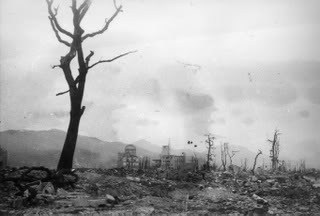
http://www.pcf.city.hiroshima.jp/virtual/img/ex0607_img/000.jpg URL: http://www.pcf.city.hiroshima.jp/virtual/VirtualMuseum_e/exhibit_e/exh0607_e/exh060701_e.html
East of hypocenter (Hiroshima)
Taken 1.4km east of the hypocenter

IMG: http://www.pcf.city.hiroshima.jp/kids/KPSH_E/hiroshima_e/sadako_e/subcontents_e/images_e/sa009-2_e.jpg
Taken 500 meters east of the hypocenter (7 August, 1945)
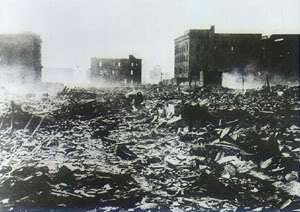
IMG: http://www.pcf.city.hiroshima.jp/virtual/img/panel_img/3107.jpg
http://www.pcf.city.hiroshima.jp/virtual/VirtualMuseum_e/visit_e/est_e/panel/A3/3107.htm
Ground Zero Hiroshima

IMG: http://www.pcf.city.hiroshima.jp/virtual/img/ex0603_img/map12_e.jpg

URL: http://www.pcf.city.hiroshima.jp/virtual/img/ex0603_img/46romendensya.jpg
The remains of a streetcar (model 100). Approx. 360m from the hypocenter, Togiya-cho (now, Kamiya-cho 1-chome) The model 100 was a wooden streetcar debuted on November 23, 1912, by Hiroshima Electric Railroad, predecessor to Hiroshima Electric Railway Company. Struck on the track as it headed out of town, it was completely burned.

IMG: http://www.pcf.city.hiroshima.jp/virtual/img/ex0603_img/47fukuya.jpg
Fukuya Department Store Approx. 710m from the hypocenter, Ebisu-cho
At the time of the bombing, the powerful blast blew furniture, equipment and other items around the building, killing many people. During the subsequent fire, the interior was completely burned, leaving only the shell. After the bombing, the shell became an emergency relief station. After August 17, it was used for a month as a temporary infectious disease hospital. The acute effects of radiation caused bloody stools, leading to a large number of victims being diagnosed with dysentery

IMG: http://www.pcf.city.hiroshima.jp/virtual/img/ex0603_img/48syoukoukai.jpg
Hiroshima Prefectural Commerce Association Approx. 260m from the hypocenter, Moto-machi. Close enough to the hypocenter to be struck from nearly directly above, the walls around the roof were pushed over to the outside. Many people photographed the destroyed downtown area from the watchtower on this surviving building because it was comparatively tall and stood just north of the Hiroshima Prefectural Industrial Promotion Hall. The atomic bomb killed 28 Commerce Association staff.

IMG: http://www.pcf.city.hiroshima.jp/virtual/img/ex0603_img/49teigin.jpg
Teikoku Bank, Hiroshima Branch Approx. 360m from the hypocenter, Kawaya-cho (now, Hondori). The external wall on the northwest side facing the hypocenter was crushed, and most of the roof collapsed. The beams and pillars inside were bent and the reinforcing steel bars stuck out. Restoration of the badly damaged building was completed in May 1950. Reborn as a bakery and restaurant, the building is now known as Hiroshima Andersen.

IMG: http://www.pcf.city.hiroshima.jp/virtual/img/ex0603_img/51fukuromachi.jpg
Fukuro-machi Elementary School Approx. 460m from the hypocenter, Fukuro-machi.
Approximately 160 faculty and students had just started cleaning up the debris from their demolished previous wooden school building. Exposed directly to the heat and blast, very few survived. The rooms on the first floor had become an emergency relief station that accommodated many injured. Hundreds of messages were scribbled on classroom blackboards and stairwell walls to tell family members where they were going.
http://www.pcf.city.hiroshima.jp/virtual/VirtualMuseum_e/exhibit_e/exh0603_e/exh060309.html
http://www.planetizen.com/node/27 Caption: Lower Manhattan on September 15, 2001. Image provided by spaceimaging.com.

http://drjudywood.com/articles/DEW/StarWarsBeam4.html

IMG: http://www.911research.com/wtc/evidence/photos/docs/ground_zero_arial_s.jpg
http://www.911research.com/wtc/evidence/photos/groundzero.html Caption: Satellite photo of Ground Zero
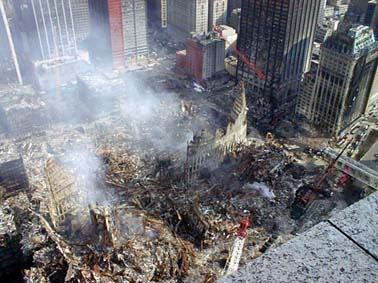
http://www.noaanews.noaa.gov/stories/s798b.htm (moved)
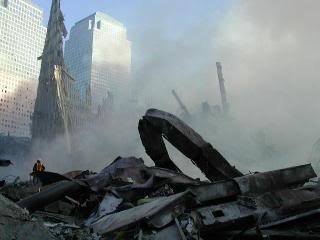
http://www.911research.com/wtc/evidence/photos/docs/dscn_0332.jpg URL: http://www.911research.com/wtc/evidence/photos/gzimmed2.html
More from: http://www.911research.com/wtc/evidence/photos/groundzero.html

http://www.911research.com/wtc/evidence/photos/docs/wtc_shattered2.jpg URL: http://www.911research.com/wtc/evidence/photos/gzimmed1.html Caption: A Photo of Ground Zero Soon After the Attack
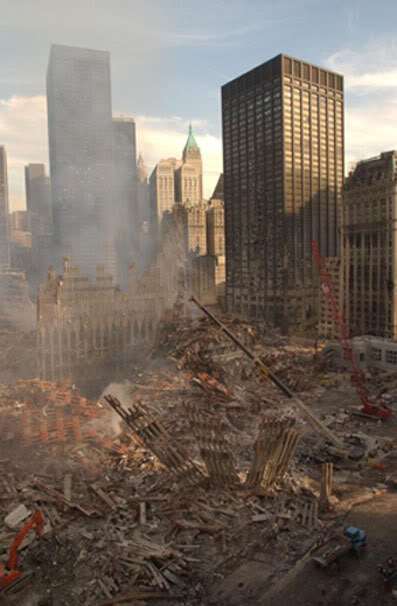
http://www.911research.com/wtc/evidence/photos/docs/gz_hd1391p50.jpg URL: http://www.911research.com/wtc/evidence/photos/gzrescue2.html
More photos of GZ from: http://www.911research.com/wtc/evidence/photos/groundzero.html
http://www.911research.com/wtc/evidence/photos/groundzero.html
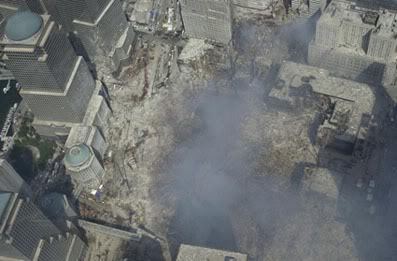
http://www.911research.com/wtc/evidence/photos/docs/oem/9_18_pic08.jpg URL: http://www.911research.com/wtc/evidence/photos/oem4.html
http://www.911research.com/wtc/evidence/photos/groundzero.html
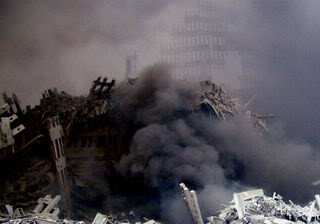
http://www.911research.com/wtc/evidence/photos/docs/wtc_cross.jpg URL: http://www.911research.com/wtc/evidence/photos/gzimmed3.html My caption: The remains of the WTC.
http://www.911research.com/wtc/evidence/photos/groundzero.html

http://www.911research.com/wtc/evidence/photos/docs/jc/jc_234.jpg URL: http://www.911research.com/wtc/evidence/photos/gzelev2.html Caption: Photos of GZ from Cortland Street.
http://www.911research.com/wtc/evidence/photos/groundzero.html
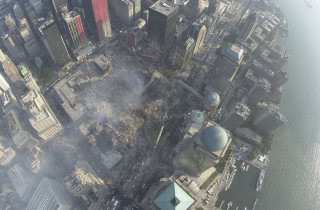
http://www.911research.com/wtc/evidence/photos/docs/oem/9_22_pic03.jpg URL: http://www.911research.com/wtc/evidence/photos/oem7.html Caption: Photos from 9/22/01. Aerial Photos of Ground Zero Provided by New York City’s Office of Emergency Management. These photographs, from 9/22/01 show Ground Zero from over 1000 feet aloft. They show the positions of several cranes.
http://www.911research.com/wtc/evidence/photos/groundzero.html
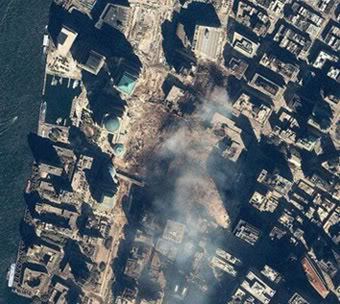
http://www.911research.com/wtc/evidence/photos/docs/ground_zero_arial.jpg URL: http://www.911research.com/wtc/evidence/photos/gzaerial1.html
http://www.911research.com/wtc/evidence/photos/groundzero.html

Nagasaki

Above: damage to the personnel camp 17 miles away (on the other side of Bikini Atoll), from the 14.8 megatons Castle-Bravo test.
http://glasstone.blogspot.com/
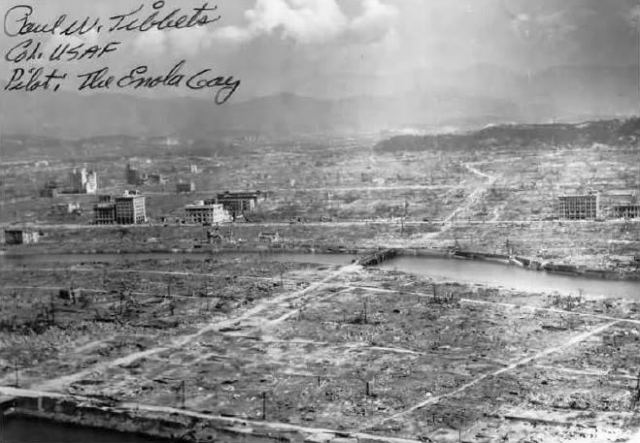
IMG: https://apunked.files.wordpress.com/2017/02/Lecture_Tibbets_border.jpg
Glaser – Tibbets – Enola Gay – desktop. Can’t find the URL. Similar picture here: http://mauialmanac.com/img/Hiroshima.jpg URL: http://mauialmanac.com/2008/08/06/hiroshima-peace-day/ Caption: August 6th, 1945: The U.S. drops the first Atomic Bomb on Hiroshima, Japan from a B-29 Superfortress bomber, the Enola Gay, piloted by Paul W. Tibbets. According to most estimates, the immediate effects of this blast killed approximately 70,000 people. Up to 200,000 had died by 1950, due to cancer and other long-term effects.

http://drjudywood.com/articles/dirt/dirt4.htm (dead link)

http://www.judywood.com/articles/why/why_indeed.html

http://www.atomicarchive.com/History/twocities/hiroshima/images/HR03.jpg URL: http://www.atomicarchive.com/History/twocities/hiroshima/image8.shtml Caption: The T-shaped Aioi Bridge, in the upper portion of the photograph, was the aim point for the Enola Gay. Only reinforced concrete buildings remain and all have sustained significant structural damage.
A young officer of the Japanese General Staff was instructed to fly immediately to Hiroshima, to land, survey the damage and return to Tokyo with reliable information for the staff. Headquarters doubted that anything serious had occurred, but the rumors were building. When the staff officer in his plane was nearly 100 miles (160 km) from Hiroshima, he and his pilot noticed a huge cloud of smoke from the bomb. In the bright afternoon, the remains of Hiroshima were burning.
The plane soon reached the city and circled it. A great scar on the land was still burning, covered by a heavy cloud of smoke.
http://www.atomicarchive.com/History/twocities/hiroshima/page10.shtml
Nagasaki two days before the atomic bombing

Nagasaki three days after the atomic bombing

http://www1.city.nagasaki.nagasaki.jp/na-bomb/museum/m2-1e.html (moved links)

http://upload.wikimedia.org/wikipedia/commons/thumb/e/ed/Nagasaki_1945_-Before_and_after.jpg/473px-Nagasaki_1945–Before_and_after.jpg URL: http://commons.wikimedia.org/wiki/File:Nagasaki_1945-_Before_and_after.jpg Caption: Nagasaki, Japan, before and after the atomic bombing of August 9, 1945.
The Scorched Plain of Hiroshima
The T-shaped Aioi Bridge in the center of the photo is the target of the bombing. The land mass lying behind the bridge and sandwiched between two rivers is Nakajima-cho (the present Peace Memorial Park).

Img: http://www.pcf.city.hiroshima.jp/kids/KPSH_E/hiroshima_e/sadako_e/subcontents_e/images_e/a2.jpg URL: http://www.pcf.city.hiroshima.jp/kids/KPSH_E/hiroshima_e/sadako_e/subcontents_e/08higai_5_e.html Caption: The Scorched Plain of Hiroshima. The T-shaped Aioi Bridge in the center of the photo is the target of the bombing. The land mass lying behind the bridge and sandwiched between two rivers is Nakajima-cho (the present Peace Memorial Park).
Hiroshima – GIF

Img: http://www.mbe.doe.gov/me70/manhattan/images/HiroshimaAnimationLarge.gif
Caption: Aerial photographs of the city of Hiroshima before (April 13, 1945) and after (August 11, 1945) the bombing.
http://www.mbe.doe.gov/me70/manhattan/hiroshima_animation.htm
Damage to buildings
Because the A-bomb exploded close to the center of the city, and because 85% of the buildings were within 3 km of the hypocenter, destruction to the city was nearly complete, with 90% of buildings collapsed or burned. (August 1946 Survey by the Hiroshima City Government)


The city center from the air in October 1945 / US Army photo
http://www.pcf.city.hiroshima.jp/peacesite/English/Stage1/1-5/1-5-7E.html (dead link)
The damage done

http://www.pcf.city.hiroshima.jp/peacesite/English/Stage1/S1-5E.html (dead link)
Video – Map of Hiroshima damaged area
IMG: http://www.pcf.city.hiroshima.jp/virtual/cgi-bin/e/bakufu.swf
The atomic explosion created a super-high pressure at the epicenter of several hundred thousand atmospheres.
The surrounding air expanded enormously, creating a tremendous blast. The blast pressure was immense, 19 tons per square meter as far away as 500 meters from the hypocenter. Nearly all buildings were crushed; people were lifted and thrown through the air.
http://www.pcf.city.hiroshima.jp/virtual/cgi-bin/museum.cgi?no=2000&l=e

IMG: http://www.pcf.city.hiroshima.jp/kids/KPSH_E/hiroshima_e/sadako_e/subcontents_e/images_e/higai_e.gif
http://www.pcf.city.hiroshima.jp/kids/KPSH_E/hiroshima_e/sadako_e/subcontents_e/08higai_5_e.html
Caption: The Damaged Area. Super-Hot Fires. The heat ray generated simultaneously with the explosion of the atomic bomb caused houses, etc., in the hypocenter vicinity to ignite spontaneously. Kitchen flames in houses collapsed by the blast spread and began to consume houses here and there. Such fires rapidly enveloped Hiroshima City in a day-long conflagration that peaked from around 10:00 a.m. to 2:00 or 3:00 p.m. Areas within a two-kilometer radius of the hypocenter were reduced to rubble. Many people trapped under houses collapsed by the blaze were burned alive.
Photos of Nagasaki and Hiroshima

http://www.atomcentral.com/NTS_project/WC1333%7E1_sm.jpg URL: http://www.atomcentral.com/HN_Images01.html Caption: Nagasaki image

http://www.atomcentral.com/NTS_project/080-G-%7E1_sm.jpg URL: http://www.atomcentral.com/HN_Images01.html Caption: Navy photographer pictures suffering and ruins that resulted from atom bomb blast in Hiroshima, Japan. Japanese soldier walks through leveled area., 09/1945.

http://www.atomcentral.com/NTS_project/hiroshima_wide_sm.jpg URL: http://www.atomcentral.com/HN_Images01.html Caption: Hiroshima close to Ground Zero
Another bomb was assembled at Tinian Island on August 6. On August 8, Field Order No.17 issued from the 20th Air Force Headquarters on Guam called for its use the following day on either Kokura, the primary target, or Nagasaki, the secondary target. Three days after Hiroshima, the B-29 bomber, “Bockscar” piloted by Sweeney, reached the sky over Kokura on the morning of August 9 but abandoned the primary target because of smoke cover and changed course for Nagasaki.
Nagasaki was an industrialized city with a natural harbor in Western Kuushu, Japan. At 11:02 a.m., this bomb, known as the “Fat Man” bomb, exploded over the north factory district at 1,800 feet above the city to achieve maximum blast effect. Buildings collapsed. Electrical systems were shorted. A wave of secondary fires resulted, adding to their holocaust.
Flash burns from primary heat waves caused most of the casualties to inhabitants. Others were burned when their homes burst into flame. Flying debris caused many injuries. A fire storm of winds followed the blast at Hiroshima as air was drawn back to the center of the burning area. Trees were uprooted. The bomb took the lives of 42,000 persons and injured 40,000 more.
It destroyed 39 percent of all the buildings standing in Nagasaki. According to U.S. estimates, 40,000 people were killed or never found as a result of the second bomb. Highly penetrating radiation from the nuclear explosion had a heavy casualty effect. Energy released by the explosion of this type of atomic bomb used over Nagasaki is roughly equivalent to the power generated by exploding 20,000 tons of TNT or 40 million pounds of TNT. It would fill two good sized cargo ships.
In the early stages of the explosion, temperatures of tens of millions of degrees were produced. The light emitted is roughly ten times the brightness of the sun. During the explosion, various types of radiations such as gamma rays and alpha and beta particles eminate from the explosion. These radiative particles give the atomic bomb its greatest deadliness. They may last years or even centuries in dangerous amounts. Gamma radiation and neutrons caused thousands of cases of radiation sickness in Japan. First the blood was affected, and then the blood making organs were impaired including the bone marrow, the spleen and the lymph nodes. When radiation was severe, the organs of the body became necrotic within a few days, marking the victim for certain death within a short period of time.
Surveys disclosed that severe radiation injury occurred to all exposed persons within a radius of one kilometer. Serious to moderate radiation injury occurred between one and two kilometers. Persons within two to four kilometers suffered slight radiation effects.
All material on this website Copyright © 2006 atomcentral.com
http://www.atomcentral.com/hironaga.html
VIDEO: Hiroshima damage Dailymotion




